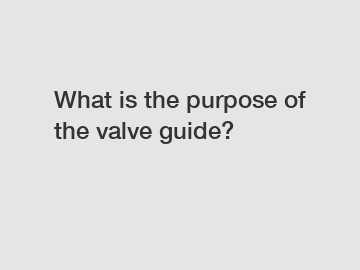What is the purpose of the valve guide?
Valve guides may seem like a small and insignificant part of an engine, but they play a crucial role in ensuring smooth and efficient operation. These small components serve as a critical link between the valve stem and the cylinder head, guiding the valve as it moves up and down in the cylinder. While valve guides may not be the most glamorous part of an engine, they are essential for proper valve function and overall engine performance.
Valve guides are cylindrical sleeves that are typically made of bronze or cast iron and are pressed or inserted into the cylinder head. The valve stem fits snugly inside the valve guide, allowing the valve to move up and down with minimal friction. This precise fit is essential for maintaining proper alignment and preventing the valve from wobbling or sticking.
One of the primary purposes of the valve guide is to help dissipate heat away from the valve stem. As the valve opens and closes, it generates a significant amount of heat due to friction and combustion temperatures. Without proper cooling, the valve stem can become overheated and weaken over time, leading to premature wear and potential engine failure. The valve guide helps to conduct heat away from the valve stem and into the cylinder head, where it can be dissipated more effectively.

Another important function of the valve guide is to provide stability and support for the valve as it opens and closes. Because the valve guide is precisely machined to fit the valve stem, it helps to keep the valve centered and aligned within the cylinder. This prevents the valve from wobbling or tilting during operation, which can lead to poor sealing, loss of compression, and reduced engine performance. In addition, the valve guide helps to control the movement of the valve, ensuring that it opens and closes smoothly and accurately.
Valve guides also play a critical role in ensuring proper valve seating and sealing. As the valve closes, it must make a tight seal against the valve seat to prevent the escape of combustion gases. The valve guide helps to guide the valve into the correct position and maintain proper alignment with the valve seat. This ensures that the valve makes a complete seal, preventing leakage and loss of compression. A worn or damaged valve guide can lead to poor sealing, reduced performance, and potential engine damage.
In addition to their functional purposes, valve guides also play a role in controlling airflow within the engine. The size and shape of the valve guide can influence the flow of air and fuel into the combustion chamber, affecting engine performance and efficiency. Properly designed valve guides can help to optimize airflow and improve combustion, leading to enhanced power output, fuel efficiency, and overall engine performance.
Despite their small size, valve guides are a critical component of any engine and play a significant role in ensuring smooth and efficient operation. By providing stability, support, and heat dissipation for the valve, valve guides help to maintain proper valve function and overall engine performance. Without well-functioning valve guides, engines can experience a host of problems, including poor sealing, reduced performance, and potential engine damage. Next time you start your car or motorcycle, take a moment to appreciate the humble valve guide and the important role it plays in keeping your engine running smoothly.
Are you interested in learning more about valve grinding tool, Stationary Grinding Machine, Portable Grinding Machine? Contact us today to secure an expert consultation!


